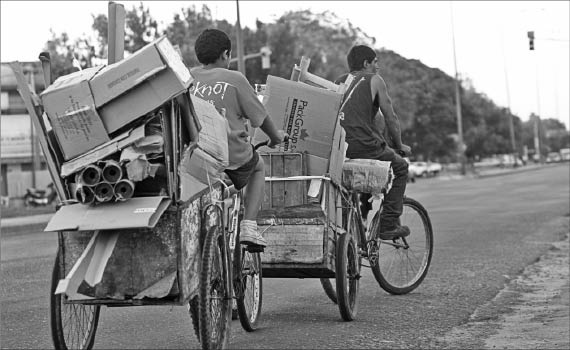“Esta es Mi Villa” is a TV show here in which the host goes to different villas around the country and interviews people. This is a clip from the episode that takes place in the province of Chubut outside of the popular vacation town Bariloche. (I’m all the way up in Santa Fe if you’ve forgotten.) Argentina’s size and spread gives it a diverse selection of climates. As you travel north towards the equator you of course get warmer, and as you head south (to Bariloche for example) you end up in the snow. If you get bored of not knowing what the narrater is saying just skip the first minute or so until he walks into the house of a woman named Rosa. Take a look at her house, especially her makeshift door and outdoor bathroom.
Reporting Live from Rosario, Argentina
Erin shares his adventures abroad with Mr. Scheuering's class at The Creative Science School
Tag Archives: villages
Poverty in Argentina
This is Maria and her son Luciano. Maria and several other mothers were sitting outside the art museum begging for pesos. I decided that, since it was almost impossible to walk by this woman and her child without giving them something, I would talk to them for a little bit.
Maria told me that they live in one of the villas outside of the city. These villas or villas miserias (which means miserable villages) are what they call the slums here in Argentina. Depending on the distance from the main city many of these villas are more like shantytowns than anything else. Maria and Luciano live in a very small brick house which has neither water or electricity. She told me that it was a busy weekend for tourists to come to Buenos Aires so she hitchhiked in with another mother. They came together to beg and planned on staying the night in the city. I asked her where she was going to sleep and she just pointed to the street. Talking to them made me feel grateful for what I have, the hotel I was sleeping in that night, the warm meal I would inevitably eat, my safety net of friends and family.
This is one of the largest villas in Argentina, Itatí, which lies just outside of Buenos Aires. As you can see a lot of this housing is thrown together with whatever materials are available. There is no electricity, running water or bathrooms in any of the houses. Villages like this are often situated in the least desirable parts of the country, near the run off and waste of the large cities.
This is Villa 31, which has existed since 1930 and is supposedly undergoing urbanization to deal with the rising number of multistoried buildings being built. These buildings are incredibly dangerous because they are constructed with found, stolen or inexpensive materials without regard for safety or construction regulations.
This is a common ‘job’ for the unemployed. There is an organization here called the Ecumenical Movement for Human Rights which pays for recyclable goods. People like these two ride bikes or horses around the cities going through the public dumpsters to collect material that can be sold to the EMHR.
I think the most interesting aspect of the poverty here is not the extent. In comparison with other countries, the unemployment and population living under the poverty line is not incredibly high. However, the disparity that exists between those with money and those without is quite startling. It’s a caliber of disparity that I’ve never seen before. Large expensive cities are surrounded by slums filled with people literally walking around in rags. You see children covered in soot begging around the nice restaurants and people sleeping on the sidewalk in front of condo buildings.
The poverty in Argentina has forced many people to desperation in their attempt to take care of themselves and their families. Some have resorted to the production, sale or use of Paco. Paco is a highly addictive and inexpensive drug that has been gaining popularity for the last few years. It has had a detrimental effect on the population here. The Argentine Reporter (another English language news source here) recently did a piece on the effects of Paco:
“Users are witheringly referred to as the muertos vivientes – the living dead – of Buenos Aires. Addictive after one or two hits, the drug systematically destroys the nervous system. Users quickly become skeletal and ravaged, resorting to crime and violence … Enormous numbers die in short order.”
The Paco problem has led to a steady increase in robberies in the cities as users run out of money and resort to stealing to pay for their addiction. In speaking with locals, it is apparent that this rise in crime and proliferation of Paco has had a noticeable effect on the city. Several of the older people that I’ve met have recalled to me the cleaner and safer city that Rosario used to be.
This video is 6 minutes long and in Spanish so feel free to skip around a bit, the first few minutes are probably the most important. It’s a story on a 15 year old in one of the villas of Cordoba, the second largest city in Argentina. Take a look at the conditions of the village he lives in. In the video he talks about his family who collect cardboard to sell to the recycling center. He says his dream is to be the president in Argentina and change the current system to help the many people that live in the villages or in the streets without money or work.




